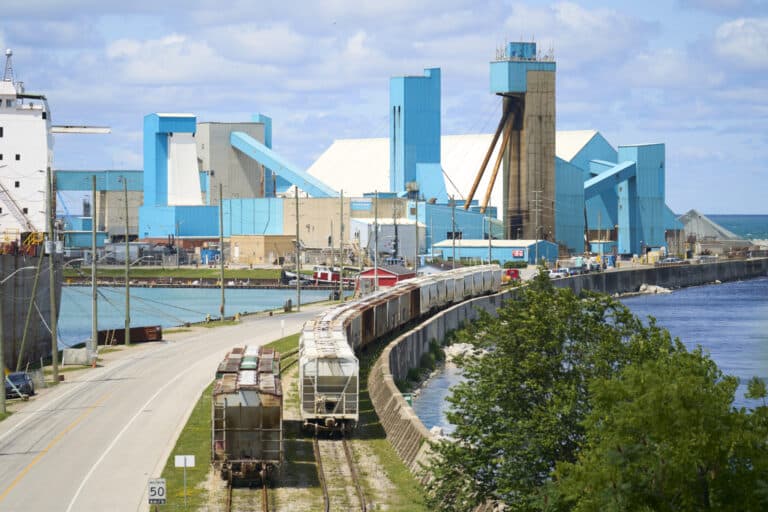A New Unifying Issue: Just About Everyone Hates Data Centers
Recent election results and evidence from states show misgivings about the growth of AI and the ramifications for energy costs and the environment.
Current Access Level “I” – ID Only: CUID holders, alumni, and approved guests only
Insights from the Center on Global Energy Policy

This Energy Explained post represents the research and views of the author(s). It does not necessarily represent the views of the Center on Global Energy Policy. The piece may be subject to further revision.
Contributions to SIPA for the benefit of CGEP are general use gifts, which gives the Center discretion in how it allocates these funds. More information is available here. Rare cases of sponsored projects are clearly indicated.
The Trump administration is increasingly using equity investments as a tool of industrial policy to support domestic critical minerals supply chains. Equity participation, including in Intel for the semiconductor supply chain, is a major departure from traditional US government policy. The new approach can catalyze the development of strategic sectors domestically, but there are real risks and questions about whether this is the best policy across all mineral supply chains.
To date, the administration has taken equity stakes in three major critical minerals ventures:
This Q&A discusses these three deals and the broader implications of US government ownership in this crucial industry of economic and national security interest.
What is the goal of equity investments by the US?
The goal of equity participation is to support the development of domestic critical minerals supply chain projects by signaling long-term policy support and commitment and potentially attracting further private capital. This approach has been considered more appropriate for Western projects in resource-rich developing countries, where US government participation can reduce perceived political and financial risk.
The US government has traditionally used grants or loans to support new mining projects. The Biden administration, for example, funded projects through the Department of Energy’s Loan Program Office (LPO) and Office of Manufacturing and Energy Supply Chains. The LPO offered below-market-rate loans, backed by strong due diligence, to projects to reduce the cost of capital for private investors.
However, some in the Trump administration have suggested that the government should be able to profit from the upside risk of projects with an ownership stake. Another potential reason for government equity investments is to have a lever to force the production of certain critical minerals even when they are not profitable but considered essential from a national security standpoint. At the same time, there is equity risk that if the project does not succeed the government will lose its initial capital injection.
Why did the administration seek an ownership stake in MP Materials?
MP Materials was formed in 2017 when it acquired the Mountain Pass mine in California. From the get-go, this company had Chinese co-ownership through Shenghe Resources, a partly state-owned rare earths company that held (at the time) a small, non-voting interest (7.7%). Shenghe was the primary buyer of the rare earths produced by MP for processing in China. This ownership share had been considered problematic for years, given the close connection between rare earths and US national security. The equity purchase by the US government means it is now the largest shareholder (at 15%), which reduces the company’s exposure to China.
What instigated the Lithium Americas investment, and what are its consequences?
The Thacker Pass mine in Nevada (a joint venture between Lithium Americas and GM) received a $2.3 billion concessional loan from the US government to help build the mine during the Biden administration. When the project sought to draw on the loan in 2025, it was unable to meet the conditions for the first disbursement and therefore had to renegotiate the loan conditions, including a delay in part of the loan repayment. In exchange for this, the government demanded a small and free equity stake of 5% in both the Thacker Pass project and in Lithium Americas.
The government justified this deal by saying it created a temporary cash buffer for the company and project due to the delayed repayment of the loan. Several investors, however, expressed considerable concerns, saying that while it helps the project’s cash flow, the free government share dilutes shareholder value. This could reduce the attractiveness to future investors in the sector if they think a project has a high chance of succeeding but worry about dilution if the government pushes itself forward as an equity investor.
Why is the administration interested in Trilogy Metals?
The investment in Trilogy Metals is unique compared to the MP Materials and Lithium Americas deals. First, the investment is being made at an earlier stage—Trilogy’s most advanced projects still need to begin the permitting process. Even under the most advanced timeline, Trilogy’s projects will not produce copper and other coproducts this decade.
Second, the equity investment was made in conjunction with approving the Ambler Road project, a 211-mile industrial road through the Alaskan wilderness that was approved during the first Trump administration but blocked during the Biden administration due to impacts on local wildlife and Indigenous lands. Trilogy Metals’s deposits, along with other potential projects, are in a remote area and the road is necessary to develop that area. The road is supported by the Alaska congressional delegation but opposed by local Indigenous groups.
This equity stake signals to the private sector that the government wants the area open for further development. The equity investment aligns with the administration’s goal of natural resource development in Alaska, including pushing for foreign investment for an liquefied natural gas pipeline in the state.
Will government equity stakes help raise private capital?
Yes and no. The firms that received US government equity stakes saw an immediate jump in their stock price because of the halo effect of government backing, but there are potential consequences for other companies in the sector. Equity stakes imply that the government is picking winners (and implicitly losers) without a competitive process or, for the time being, without a transparent due diligence process.
And when the US government takes equity positions in specific critical minerals firms, it implicitly signals that unsupported projects face higher risk. That can make early-stage investment more expensive and steer corporate attention toward political capital rather than project fundamentals and productivity. Less politically savvy firms whose operational and financial performance are actually superior could face blowback in this environment.
Has the United States previously taken ownership positions in critical minerals companies?
The Trump administration has elevated the use of equity participation in important sectors, but this is not the first time the United States has taken ownership stakes to build out critical minerals supply chains.
The US International Development Finance Corporation (DFC) has invested $105 million in TechMet, a critical minerals investment firm. TechMet was supported by the first Trump administration and subsequently by the Biden administration. DFC is now one of TechMet’s largest shareholders. In 2023, the DFC provided a $50 million equity investment in TechMet to be used specifically for the Phalaborwa Rare Earths project being developed by Rainbow Rare Earths in South Africa.
The DFC is also investing in the Orion Critical Mineral Consortium with Orion Resources Partners and ADQ on a similar partnership to finance critical minerals projects. Conversations began during the Biden administration. Partnering with TechMet and Orion helps lessen the potential of picking projects for political reasons instead of project fundamentals because the participating financial institutions are industry experts investing their own capital.
What other mechanisms besides equity stakes can be considered?
Level-playing-field tools are generally better suited than individual equity investments to unlock innovation and incentivize multiple players, including junior mining companies. Instead of firm-specific equity, instruments that apply equally to all qualified projects can help to more broadly incentivize private investment into the critical minerals sector. These mechanisms include transferable production or investment tax credits for minerals, genuine permitting reform, and price-stabilization contracts.
Treasury Secretary Scott Bessent said the administration is looking at policy options beyond equity stakes in response to the latest rare earths export restrictions by China, including price floors. Equity investments can be a key mechanism for specific projects, but broader price stabilization mechanisms would create a more competitive environment. Multiple companies would have the same incentive to begin production, encouraging increased investment into the market. But any policy would need to be crafted carefully and could cost more than equity investments because it would apply to multiple producers and solve for an operating expense problem rather than a capital expense problem.
The new critical minerals agreement between Japan and the US is more than yet another bilateral trade announcement.

CGEP scholars reflect on some of the standout issues of the day during this year's Climate Week

President Trump has ended the federal government’s use of the "social cost of carbon" (SCC), an official estimate of the harms caused by carbon dioxide emissions.

In July, Republicans in Congress passed their signature domestic policy package, the One Big Beautiful Bill Act (or, H.R. 1).

The report outlines five foundational choices if a stockpiling strategy is adopted, as bipartisan support suggests is possible.

Natural resources and critical minerals are more important than ever. Here's how Canada can be a global leader

Lithium plays a critical role in the global energy transition. It is the core ingredient of lithium-ion batteries that power electric vehicles (EVs) and are used in stationary energy storage systems.
